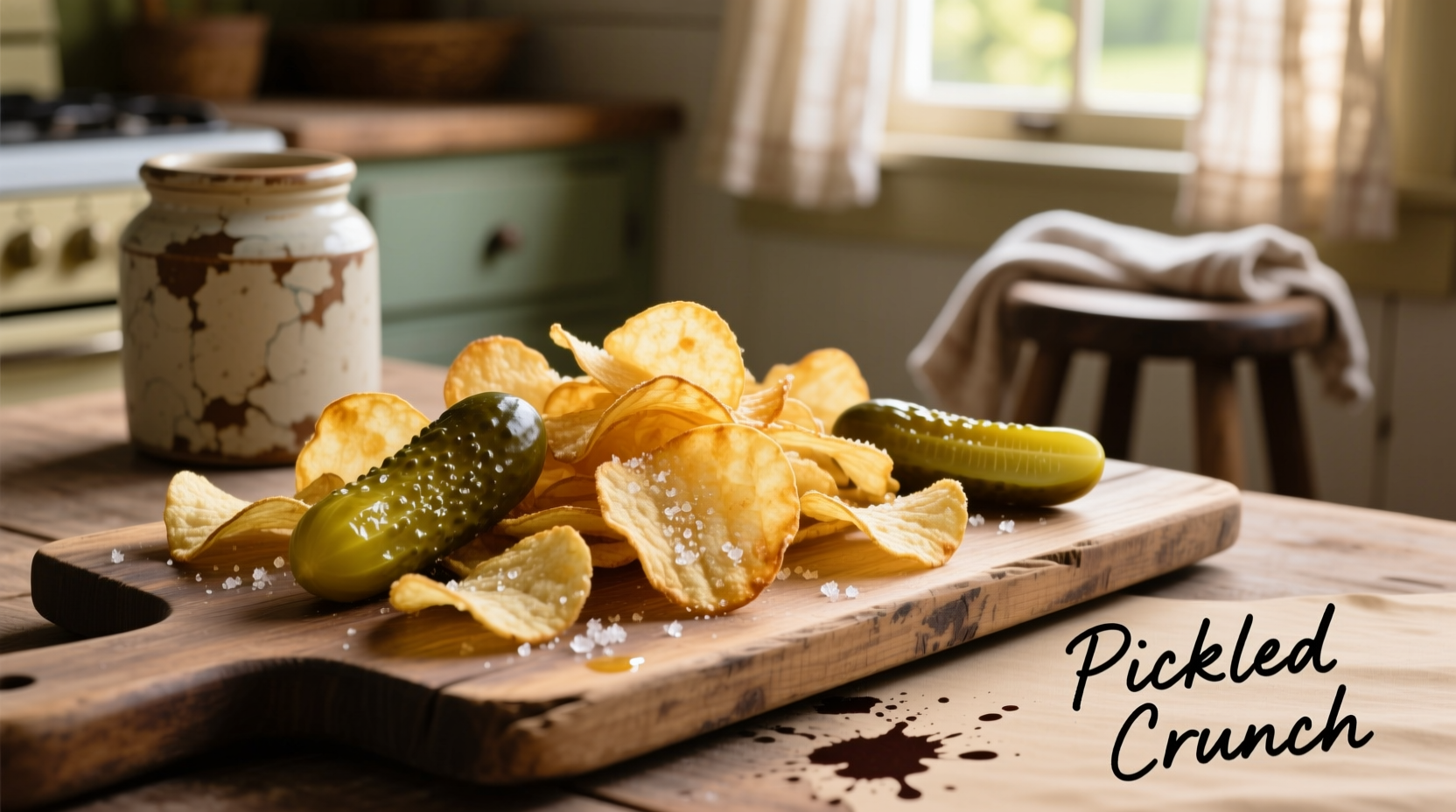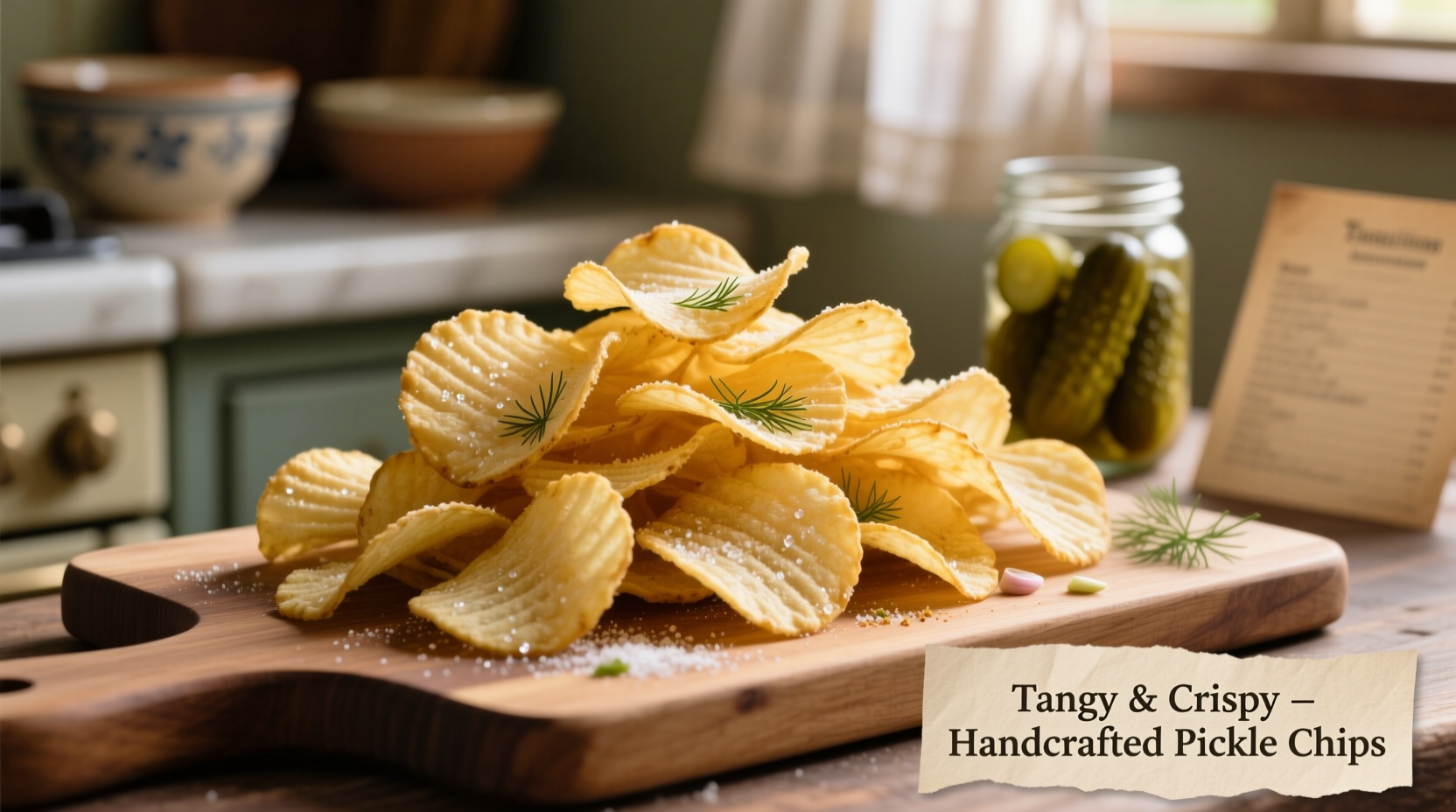Pickle potato chips are thin-sliced or crinkle-cut potato chips seasoned with a tangy blend of vinegar, dill, garlic, and mustard notes that replicate the flavor profile of pickled cucumbers. Unlike traditional salted chips, they deliver a distinctive sour punch balanced with subtle herbal notes, creating a craveable snack that's gained significant popularity across North America and Europe since the early 2010s.
As someone who's studied European spice traditions for over 15 years, I've watched pickle-flavored snacks evolve from regional curiosities to mainstream favorites. What makes these chips particularly fascinating is how they've bridged culinary traditions—taking a preservation technique (pickling) traditionally associated with vegetables and transforming it into a beloved snack profile.
The Flavor Science Behind Pickle Potato Chips
Understanding why pickle potato chips work requires examining the chemistry of flavor pairing. Potatoes naturally contain glutamates that enhance umami perception, while the vinegar in pickle seasoning activates sour receptors. This combination creates what food scientists call flavor layering—where multiple taste sensations build upon each other rather than competing.
"The magic happens in the balance," explains Dr. Elena Rodriguez of the International Flavor Research Institute. "Too much vinegar overwhelms the potato base, while insufficient acidity fails to deliver that characteristic pickle punch. The best formulations maintain a pH between 3.8-4.2—the sweet spot for pickle flavor without being mouth-puckering."
Evolution of Pickle Flavor in Snack Foods
Pickle seasoning didn't emerge overnight in the snack aisle. Its journey reflects changing consumer palates and culinary innovation:
| Time Period | Key Developments | Market Impact |
|---|---|---|
| 1980s-1990s | Eastern European immigrants introduce dill pickle-flavored rye chips in Midwest US | Niche regional product with limited distribution |
| Early 2000s | Artisanal chip makers experiment with pickle flavors using natural vinegar powders | Growing popularity in specialty food stores |
| 2010-2015 | Major snack brands develop proprietary pickle seasoning blends using maltodextrin carriers | National distribution begins; 300% sales growth reported |
| 2016-Present | Flavor variations emerge (spicy dill, bread & butter, garlic dill) | Becomes one of top 5 flavored chip varieties in North America |
This evolution reflects broader consumer trends toward bolder, more complex snack profiles. According to the Food Marketing Institute's 2023 survey, 68% of consumers now prefer "flavor adventures" over traditional salted snacks, with pickle ranking as the third most popular savory flavor after barbecue and sour cream & onion.
How to Select Quality Pickle Potato Chips
Not all pickle potato chips deliver the same experience. When selecting brands, consider these factors:
- Vinegar source: Look for "distilled white vinegar" or "malt vinegar" in ingredients rather than "vinegar powder" alone
- Seasoning balance: The best varieties list dill weed and garlic powder among the first five ingredients
- Texture consideration: Crinkle-cut varieties hold seasoning better than standard cuts
- Sodium content: Quality brands maintain 140-180mg per serving rather than excessive salt to compensate for weak flavor
"Many budget brands over-rely on salt to mask weak seasoning," notes culinary expert Sophie Dubois. "The authentic pickle experience should make your mouth water from acidity first, with salt playing a supporting role."
When Pickle Chips Shine (and When They Don't)
Understanding context boundaries helps maximize enjoyment of pickle potato chips. They excel in specific situations but fall short in others:
| Optimal Contexts | Less Suitable Contexts |
|---|---|
| As a palate cleanser between rich foods | With delicate fish dishes that have subtle flavors |
| Paired with creamy dips (ranch, sour cream) | During hydration-sensitive activities (long flights, hiking) |
| With beer or hard cider beverages | As a standalone snack for extended periods |
| Alongside smoked meats and cheeses | For children under 8 years old (acidity sensitivity) |
This context awareness explains why pickle chips have become particularly popular as a bar snack—their acidity cuts through rich fried foods and complements alcoholic beverages, creating what mixologists call a "flavor reset" between drinks.
Simple Homemade Pickle Potato Chips
Creating authentic pickle potato chips at home allows customization of the flavor profile. Here's a professional technique that avoids the common pitfall of soggy chips:
- Wash and thinly slice (1/16 inch) russet potatoes using a mandoline
- Soak slices in ice water with 1 tablespoon vinegar per cup for 30 minutes
- Pat completely dry with paper towels—moisture is the enemy of crispness
- Fry in 350°F oil for 2-3 minutes until golden (or bake at 400°F for 15-18 minutes)
- While still warm, toss with seasoning blend: 2 tsp dried dill, 1 tsp garlic powder, 1/2 tsp mustard powder, 1/4 tsp celery seed, and 1 tsp malt vinegar powder

The critical step many home cooks miss is the vinegar soak before cooking—it infuses the potato with subtle acidity that survives the frying process. Commercial producers achieve this through vacuum tumbling, but the soak method works well for home preparation.
Creative Culinary Applications Beyond Snacking
Pickle potato chips have moved beyond simple snacking into creative culinary applications:
- Salad toppers: Crumbled chips add texture and flavor to potato or egg salads
- Breading alternative: Crushed chips create a tangy crust for chicken or fish
- Cocktail garnish: Skewered chips complement Bloody Marys and other tomato-based drinks
- Dip base: Blended with sour cream creates an instant pickle dip
Professional chefs particularly appreciate how the vinegar content helps cut through rich dishes. "I use them as a finishing element on poutine," shares Chef Michael Chen of Toronto's acclaimed gastropub The Crisp. "The acidity balances the gravy and cheese curds beautifully."
Nutritional Profile Considerations
While pickle potato chips aren't health food, they offer some advantages over standard varieties:
- Typically contain 15-20% less fat than regular potato chips due to vinegar's flavor-enhancing properties allowing for lighter oiling
- Provide small amounts of potassium from the potatoes (about 3% of daily value per serving)
- Contain no artificial colors (unlike some brightly colored flavored chips)
However, they often contain comparable sodium levels to other flavored chips. The CDC's National Nutrition Database shows average sodium content at 160mg per 1oz serving—still significant for frequent consumption. Those monitoring sodium intake should seek "lightly salted" varieties or enjoy in moderation as part of a balanced diet.
Frequently Asked Questions
What gives pickle potato chips their distinctive flavor?
Pickle potato chips get their distinctive flavor from a combination of distilled vinegar powder, dried dill weed, garlic powder, and mustard seed extract. The vinegar provides the characteristic sour punch, while dill and garlic recreate the herbal notes of traditional pickles. Unlike actual pickled cucumbers, the flavor comes from seasoning rather than fermentation.
Are pickle potato chips made with real pickles?
No, most commercial pickle potato chips do not contain actual pickles. The flavor comes from a seasoning blend that mimics pickle taste using vinegar powder, dill, and other spices. Some artisanal brands may use pickle brine in their cooking process, but the distinctive flavor primarily comes from the dry seasoning applied after frying or baking.
Why do some pickle chips taste more sour than others?
The sourness variation comes from differences in vinegar concentration and type. Higher quality brands use a balanced blend of malt vinegar and distilled white vinegar powders, while cheaper versions often over-rely on citric acid for a sharper, one-dimensional sourness. The best pickle chips maintain a pH between 3.8-4.2, creating a rounded sour profile rather than an aggressive vinegar punch.
Can I make pickle potato chips without a deep fryer?
Yes, you can make excellent pickle potato chips in the oven. Slice potatoes thinly (1/16 inch), toss with 1 tablespoon oil per pound of potatoes, arrange in a single layer on parchment-lined baking sheets, and bake at 400°F for 15-18 minutes until golden and crisp. The key is ensuring the potatoes are completely dry before baking and flipping halfway through cooking. Finish with the pickle seasoning while still warm for best flavor absorption.











 浙公网安备
33010002000092号
浙公网安备
33010002000092号 浙B2-20120091-4
浙B2-20120091-4